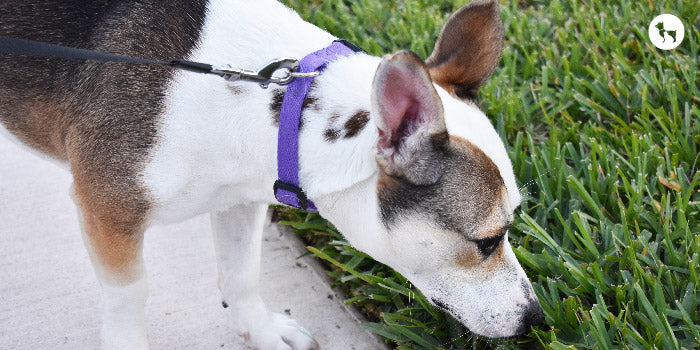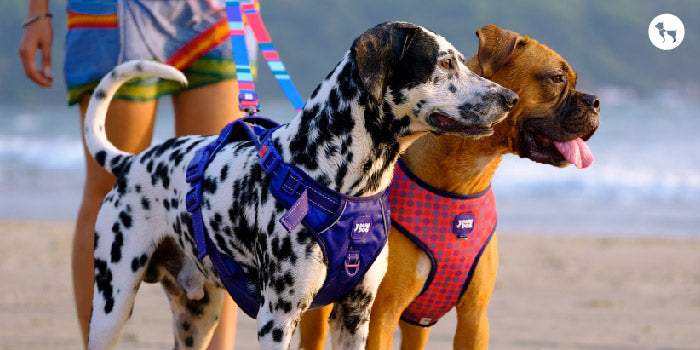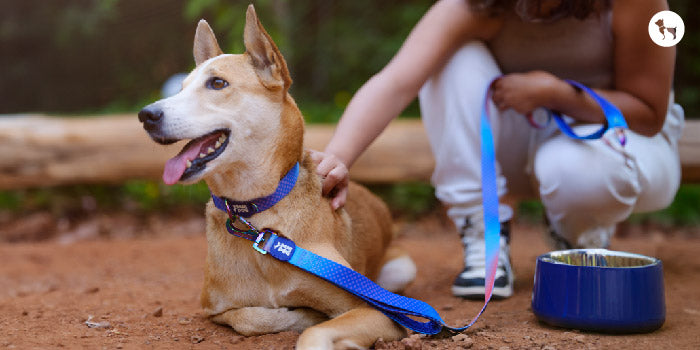7 min read
“Want to go for a walk?”
A phrase in our pet’s dictionary that means a swing of the tail and a swirl of the heart - all in joy! A dog’s day is never complete without tasting the crisp air of the great outdoors. After all, that’s where all the new scents, new humans and squirrels to chase are! Not to mention the different furry friends who they get to greet with a good old sniff of the butt. Walkies, as they’re fondly called, are every pet dog’s dream. We’re taking the liberty to dub it as a dream for it’s often taken lightly and dreams seldom are. Daily walks are a dream that brings with them different responsibilities to our lives as pet parents. And as our dogs’ forever companions, it is with us that lies the honour and the duty of making sure their dream bears fruit.
From daily walks to hikes, today we’ll look beyond the dog walk essentials your pet needs for their outdoor adventures. We’ll also seek answers to the why and the how and end it with a hope that when you take your next steps out of the house, you’ll have learnt enough to look at the world through your dog’s eyes (or dare we say, nose).
|
Table Of Contents: - 1. WALKS: A DOG’S RIGHT TO HAPPINESS 2. WHAT DOES SNIFFING MEAN FOR DOGS? |
How seriously should dog walks be taken? The AWBI (Animal Welfare Board Of India) highlights the importance of dog walks, reminding us that dogs who are not properly exercised can turn aggressive. What’s often unknown is that it’s also illegal to deny dogs the exercise they require.
Denying our dogs the right to stretch their legs and regulate their nervous system can cause severe physical ailments. Apart from keeping their weight in check, walks also serve to stimulate our dog’s senses, giving them the mental enrichment they need. So not only walks are just about physical health, but they’re also about our dog’s happiness. Remember, bored dogs can become lazy, in turn making them gain weight and the vicious cycle shall continue if we cease following their walk schedule.
In short, walks are a dog’s right in India.

When you’re out on a walk, you’ll notice that your dog will sniff everything! Most pet parents feel annoyed when they have to wait at a particular place for long. But have you ever stopped to wonder why our dogs do that? What’s so fascinating about a tyre? Or the bark of a tree? Or a specific bush they’ve been sniffing for the past 5 minutes? What makes the act of sniffing special?
Sniffing is not just a silly habit for our dogs, it is their entry into the world beyond ours. A dog’s nose has over 300 million olfactory receptors (humans have 6 million) and can smell 1,00,000 times better than us! This super sniffer snout is always working on communicating, exploring and gathering crucial information about their environment. It’s so wonderful that it can even smell the passage of time! One single sniff can identify any potential threats, presence of other animals, remaining scent trails of other dogs and even gather a full biodata about the other dog’s size, gender and health. Once the information is collected, the nose will help the mind create a 3D image in our dog’s mind. How incredible!
The moral of the story, be patient and let your dogs sniff as much as they’d like.
We covered the ‘why walks’. Now, we move on to the how. How can we make this dream of our dogs an even better and safer one? Here are 5 walk essentials for dogs that’ll answer this question for you and make your outdoor adventures with your dogs even more fun!
Collars for dogs are the original walking gear and accessory. They are familiar not just to us but the passerby as well. It’s a symbol of belongingness and an indication that the dog is well taken care of.
While selecting a dog collar for your furry family member, you’ll want to ensure it has certain features that will make your dog’s walking experience as smooth as possible. First comes comfort. Ensure the collar is adjustable and of the right size. A size too small can restrict your dog’s neck movement and even cause pressure on their windpipe while a smaller size can make your dog wiggle out of them and run free. Second comes safety. Does the collar have a safety buckle? Is the fabric strong enough or will it tear easily? Does the collar come with a strong D-ring attachment that’ll keep the leash connected in case of strong pulling? Is there a ring to attach their ID tags?
Our bestsellers are the nylon dog collars but there are other options for you to choose from as well. A martingale dog collar is designed especially for strong pullers and provides security without compromising comfort. These dog collars fit loosely around the dog’s neck but tighten when necessary, preventing your dog from escaping. It’s a snug yet gentle fit. Apart from walks, we find them useful to be used during dog training as well.
Padded dog collars are also perfect for some additional comfort. A personal favourite of ours is reflective dog collars as they make night runs so much fun!
HUFT Tip: Ensure your dog doesn’t pull too hard on the leash while wearing a collar to prevent choking. Dedicate enough time to leash train your dog for a safer walk. Teaching them to not pull will go a long way in ensuring their safety on walks.

A dog’s neck is a sensitive part of a dog’s body that plays a vital role in movement and safeguarding numerous muscles, including the windpipe. If your dog is ever so excited and tends to pull harder on their leash than an average dog, a dog harness is a better fit than a dog collar.
Harnesses for dogs are, according to us, a safer and more comfortable walk essential for dogs. Each is designed to evenly distribute your dog’s weight thereby minimising pressure on the neck during walks. When placed correctly, they free up the shoulder muscles (which the dogs use to move around) and remove potential risks of neck damage.
While choosing a dog harness, you’ll want to pick one that comes with strong security buckles for quick wear. They should be adjustable at both neck and girth and have a breathable fabric so your dog doesn’t feel hot when they’re out. Our bestseller is Dash Dog Walk Along dog harness that removes pressure from the dog’s neck, has a handle at the back to control the dog’s movement and also comes with a reflective webbing for a night run. Plus, it’s made from ripstop fabric to avoid rip and tear!
Read More: Dog Collar or Dog Harness: What does your dog need?

While one may say going leash-free with our dogs means more freedom, we find dog leashes to be a beautiful way to connect and communicate with our dogs while out on walks. A nudge, a tug or a pull on the leash translates different messages to our pets. A gentle tug can say, “Hey, let’s not go there”. A tight leash can mean, “Stay close to me” while a loose leash can mean, “There’s plenty of space for you to explore!”.
A dog leash helps us bond with our dogs in so many different ways and also helps them socialise safely. Leash training your dog can go a long way in ensuring your dog’s safety outdoors. We recommend staying in touch with a canine behaviourist for the same.
Now, let’s talk about leash shopping. How to choose one? Apart from the basics such as having safe carabiner locks, a leash should be selected on the basis of your need. Nylon dog leashes are lightweight, comfortable and easy to walk with but we personally love leashes with a padded handle as they help prevent blisters on your hands. Walking two dogs at once and having trouble handling two different leashes at once? Our double leashes for 2 dogs will make your walks easier!
Read More: The Ultimate Guide To Leash Walking Your Dog
We hope that your pet never strays away from you. But if such an unfortunate circumstance occurs, name tag for dogs will help strangers recognise your dog and give you a call to alert you of their location. Your pet should have an updated and personalised name tag on their collar or harness at all times. Keep a spare at home for emergencies in case the current one gets damaged or lost.
HUFT Tip: We’ve encountered multiple rescue dog stories that have been successful because of this one tiny accessory on your dog’s walking gear. So do take your pet’s safety seriously!

When they’re burning all those calories, your dog’s bound to be thirsty. An essential you should never forget on your dog’s walk is a portable dog bowl. With its lightweight, collapsible design, these dog bowls are easy to pack and carry, ensuring your dog stays hydrated and nourished on the go!
A sturdy and safe dog harness with an easy grip handle for emergencies is best for taking your dog hiking. Along with it, you’ll need a dog leash with a sturdy carabiner. Collapsible water bowl, plenty of water, poop bags, a first-aid kit, paw balm and pet wipes will also come handy. Always remember to make your dog wear their ID tag before heading outdoors.
Always carry collapsible water bowls for dogs along with plenty of water to ensure your dog stays hydrated during outdoor activities. If you feel your dog is exhausted, it’s a good idea to return home so they can get plenty of rest.
You can take packets of bite-sized training treats or your dog’s regular treats that are also lightweight and can be broken into smaller pieces. Make sure they’re high in protein and low in fat. Make sure you do not overfeed your dog as it can upset their stomach while hiking. If the treats are too dry, give them some water in a collapsible dog bowl.
Anti-tick and flea powder or a bug repellent massage oil specially created for dogs are good on-the-go solutions. While hiking, avoid walking in the rain, tall grass or heavily wooded areas as these pests tend to hide in warm areas. Perform regular tick checks during and after your hike.
What should I do if my dog gets injured or lost during an outdoor adventure? If your dog is injured, assess the situation and provide first aid. If the injury is serious, we recommend reaching out to the nearest vet in the area. You can also video call your regular vet if possible. If your dog is lost, remember to stay calm and patient. Call out their name and whistle. Then proceed to listen for responses or any sign of movement. Create a trail with their regular dog treats from where you last saw them. Take help with other hikers or your local authorities. And as a prevention for the future, ensure your dog masters the recall command
Yes, there are several safety precautions to take when hiking with your dog. Always keep them on a leash and stop them from wandering off alone. Be mindful of the weather conditions and change your plans accordingly. Watch for signs of overheating or exhaustion in your dog. Be mindful of other hikers and wildlife along the trail. Choose common and open trails that aren’t too familiar to the local authorities. And lastly, make sure your dog is up to date on their vaccinations and has proper identification on them in case they are separated from you.
POSTED IN :
Has an enthusiastic dog kiss ever made you question your life choices and made you think “How can...
If you’ve found your way here, chances are either you’ve been sniffing on the internet looking f...